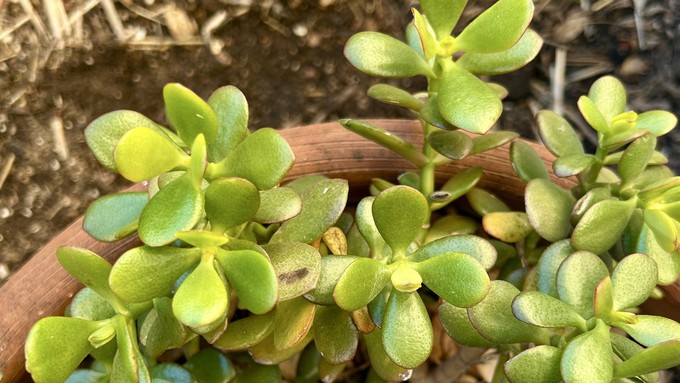
Succulents, holiday poinsettias among most sensitive plants

Jade plants and other succulents are not frost-tolerant, so move them indoors or next to a building, or put them under a frost cloth. Kathy Morrison
Brrrrrr! Feel the chill?
It may not feel like it right now, but this has been a very warm year. For most of 2024, Sacramento has been spared from freezing temperatures with only a handful of frosty nights.
But this long weekend, our gardens are definitely getting a cold check.
According to the National Weather Service, Sacramento dipped down to a low of 32 degrees on Thanksgiving and was slow to warm up. The average temperature for all 24 hours on Thursday was only 45.5 degrees – 4.4 degrees below normal for that date. Although we eventually reached a high of 59 degrees, it felt chilly all day.
That 32-degree low was the coldest night in Sacramento in all of 2024. (Normal for late November: 43 degrees.)
And we’re not done; the weather service says to expect more patchy areas of frost and morning fog.
In Sacramento, overnight lows will be dipping to 35 degrees or lower on Friday and Saturday – cold enough to damage sensitive plants. They’re not used to the cold.
* Most at risk are those pretty (and tender) poinsettias. Temperatures below 40 degrees will burn the leaves and bracts of poinsettias, which are native to Mexico. They definitely won’t last until Christmas outdoors.
* These chilly nights also can speed the decay of decorative pumpkins. To avoid damage to poinsettias, pumpkins or other holiday decorations, bring them indoors.
* Also provide frost protection for tender new seedlings such as newly transplanted cabbage or lettuce. Slip a plastic milk jug over the whole plant; it becomes an instant mini greenhouse.
* Provide protection for succulents or any remaining pepper or tomato plants. They’ll definitely feel the chill.
* Bring container plants indoors or put them under cover. Use cloth sheets (not plastic) for temporary protection. Make sure to remove these sheets during the day so plants don’t overheat and smother.
* Except for succulents, water frost-tender plants in the late afternoon before a chilly night is predicted. That extra moisture raises the soil temperature just enough to avoid frost burn.
For more tips on freezing and frost: https://ipm.ucanr.edu/PMG/GARDEN/ENVIRON/frostdamage.html.
Comments
0 comments have been posted.Sacramento Digs Gardening to your inbox.
Food in My Back Yard Series
May 6: Maintain soil moisture with mulch for garden success
April 29: What's (already) wrong with my tomato plants?
April 22: Should you stock up on fertilizer? (Yes!)
April 15: Grow culinary herbs in containers
April 8: When to plant summer vegetables
April 1: Don't be fooled by these garden myths
March 25: Fertilizer tips: How to 'feed' your vegetables for healthy growth
March 18: Time to give vegetable seedlings some more space
March 11: Ways to win the fight against weeds
March 4: Potatoes from the garden
Feb. 25: Plant a fruit tree now -- for later
Feb. 18: How to squeeze more food into less space
Feb. 11: When to plant? Consider staggering your transplants
Feb. 4: Starting in seed starting
Sites We Like
Garden Checklist for week of May 11
Make the most of the lower temperatures early in the week. We’ll be back in the 80s by Thursday.
* Plant, plant, plant! It’s prime planting season in the Sacramento area. Time to set out those tomato transplants along with peppers and eggplants. Pinch off any flowers on new transplants to make them concentrate on establishing roots instead of setting premature fruit.
* Direct-seed melons, cucumbers, summer squash, corn, radishes, pumpkins and annual herbs such as basil.
* Harvest cabbage, lettuce, peas and green onions.
* In the flower garden, direct-seed sunflowers, cosmos, salvia, zinnias, marigolds, celosia and asters. (You also can transplant seedlings for many of the same flowers.)
* Plant dahlia tubers.
* Transplant petunias, marigolds and perennial flowers such as astilbe, columbine, coneflowers, coreopsis, dahlias, rudbeckia and verbena.
* Keep an eye out for slugs, snails, earwigs and aphids that want to dine on tender new growth.
* Feed summer bloomers with a balanced fertilizer.
* For continued bloom, cut off spent flowers on roses as well as other flowering plants.
* Add mulch to the garden to maintain moisture. Mulch also cuts down on weeds. But don’t let it mound around the stems or trunks of trees or shrubs. Leave about a 6-inch-to-1-foot circle to avoid crown rot or other problems.
* Remember to weed! Pull those nasties before they set seed.
* Water early in the day and keep seedlings evenly moist.